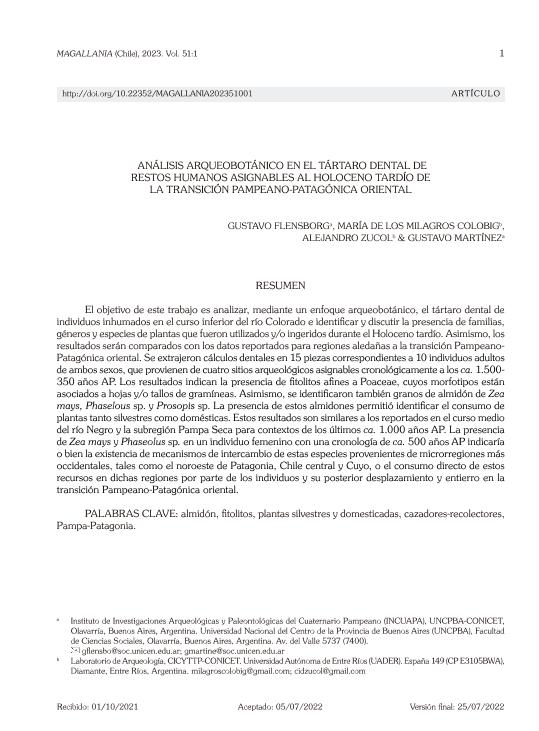Artículo
El objetivo de este trabajo es analizar, mediante un enfoque arqueobotánico, el tártaro dental deindividuos inhumados en el curso inferior del río Colorado e identificar y discutir la presencia de familias, géneros y especies de plantas que fueron utilizados y/o ingeridos durante el Holoceno tardío. Asimismo, los resultados serán comparados con los datos reportados para regiones aledañas a la transición PampeanoPatagónica oriental. Se extrajeron cálculos dentales en 15 piezas correspondientes a 10 individuos adultos de ambos sexos, que provienen de cuatro sitios arqueológicos asignables cronológicamente a los ca. 1.500-350 años AP. Los resultados indican la presencia de fitolitos afines a Poaceae, cuyos morfotipos están asociados a hojas y/o tallos de gramíneas. Asimismo, se identificaron también granos de almidón de Zea mays, Phaselous sp. y Prosopis sp. La presencia de estos almidones permitió identificar el consumo de plantas tanto silvestres como domésticas. Estos resultados son similares a los reportados en el curso mediodel río Negro y la subregión Pampa Seca para contextos de los últimos ca. 1.000 años AP. La presencia de Zea mays y Phaseolus sp. en un individuo femenino con una cronología de ca. 500 años AP indicaría o bien la existencia de mecanismos de intercambio de estas especies provenientes de microrregiones más occidentales, tales como el noroeste de Patagonia, Chile central y Cuyo, o el consumo directo de estos recursos en dichas regiones por parte de los individuos y su posterior desplazamiento y entierro en la transición Pampeano-Patagónica oriental. The objective of this work is to analyze the dental calculus of individuals buried in the lower basin of the Colorado River through an archaeobotanical approach. The presence of families, genera and species of plants that hunter-gatherer groups used and/or ingested during the Late Holocene is discussed. The results are compared with the data reported in neighboring regions east to the Pampa-Patagonia transition. Dental calculus from 15 teeth corresponding to 10 adult individuals of both sexes was collected and analyzed. The samples were recovered from four archaeological sites dated from ca. 1.500 to 350 years BP. The results indicate the presence of phytoliths related to Poaceae, whose morphotypes are associated with leaves and/or stems of grasses. Starch grains of Zea mays, Phaselous sp. and Prosopis sp. were also identified. The presence of these starches indicates the consumption of both wild and domestic plants. These results are similar to those reported for the middle course of the Negro River and the Dry Pampa subregion for contexts dated to the last ca. 1.000 years BP. The presence of Zea mays and Phaseolus sp. in a female individual with a chronology of ca. 500 years BP indicates either the existence of exchange mechanisms of these species with western regions, such as Northwest Patagonia, central Chile and Cuyo, or the direct consumption of these resources in some of those regions by individuals who later moved to be finally buried at the eastern Pampa-Patagonia transition.
Análisis arqueobotánico en el tártaro dental de restos humanos asignables al holoceno tardío de la transición pampeano-patagónica oriental
Título:
Achaeobotanic analysis in dental calculus of late holocene human remains from the eastern pampa-patagonia transition
Flensborg, Gustavo Ariel ; Colobig, María de Los Milagros
; Colobig, María de Los Milagros ; Zucol, Alejandro Fabián
; Zucol, Alejandro Fabián ; Martinez, Gustavo Adolfo
; Martinez, Gustavo Adolfo
 ; Colobig, María de Los Milagros
; Colobig, María de Los Milagros ; Zucol, Alejandro Fabián
; Zucol, Alejandro Fabián ; Martinez, Gustavo Adolfo
; Martinez, Gustavo Adolfo
Fecha de publicación:
01/2023
Editorial:
Universidad de Magallanes
Revista:
Magallania
e-ISSN:
0718-2244
Idioma:
Español
Tipo de recurso:
Artículo publicado
Clasificación temática:
Resumen
Palabras clave:
ALMIDON
,
FITOLITOS
,
PLANTAS SILVESTRES Y DOMÉSTICAS
,
CAZADORES-RECOLECTORES
Archivos asociados
Licencia
Identificadores
Colecciones
Articulos(INCUAPA)
Articulos de INVESTIGACIONES ARQUEOLOGICAS Y PALEONTOLOGICAS DEL CUATERNARIO PAMPEANO
Articulos de INVESTIGACIONES ARQUEOLOGICAS Y PALEONTOLOGICAS DEL CUATERNARIO PAMPEANO
Citación
Flensborg, Gustavo Ariel; Colobig, María de Los Milagros; Zucol, Alejandro Fabián; Martinez, Gustavo Adolfo; Análisis arqueobotánico en el tártaro dental de restos humanos asignables al holoceno tardío de la transición pampeano-patagónica oriental; Universidad de Magallanes; Magallania; 51; 1-2023; 1-17
Compartir
Altmétricas



